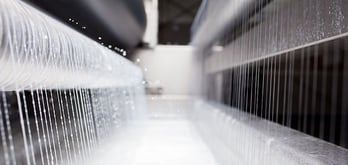The critical reason for a wire and cable manufacturer to use a water blocking treatment in their product is to prevent access and dissipation of water and moisture throughout the cable. When deciding on which treatment to use (i.e. gel, yarn, or powder based) in your cable, it’s important to consider the advantages and disadvantages of each application method.
|
Water Blocking Treatment Type |
Advantages |
Disadvantages |
|
Gel Water Blocking |
|
|
|
Powder Water Blocking |
|
|
|
Yarn Based Water Blocking |
|
|
In a gel-filled cable, any space in the tube that is not occupied is filled with impermeable gel. Using this type of water blocking material can cause many challenges for installers in regard to time, cost and the mess created by the product. Having to clean gel from fibers can slow down the installation process and cause significant mess for technicians operating machinery, splicing or terminating this type of cable. However, the effectiveness of a gel filled cable cannot be understated as gel water blocking completely prevents any kind of moisture ingress as there is no additional space for the water to fill.
Super absorbent polymers (also referred to as SAP or slush powder) can absorb and retain extremely large amounts of a liquid relative to their own mass. Powder based water blocking involves directly applying the SAP powder to a cable. SAP powder is typically manufactured with a very fine particle size to maximize surface area available for water absorption. Applying a water blocking treatment in this fashion, while effective, can result in the SAP powder getting all over the surrounding equipment and areas.
In contrast to the inefficiencies experienced with gel and powder based water blocking, there are also many benefits to the use of dry, yarn based, water blocking that are now widely recognized.
With yarn based water blocking, yarns are used a carrier for SAP, instead of applying it directly onto and into the cable. This allows the water blocking component to be applied to the cable with minimal shedding or contamination of equipment. There are several methods available to apply SAP to yarns including solvent, aqueous or oil based treatments, either heat cured or applied under ambient conditions. In addition, there are yarns available in which the yarn itself is made from a swellable fiber. The absence of sticky grease or gel in yarn based water blocking offers a major reduction in time needed to prepare a cable for splicing, a decrease in cable weight, and no need for solvents or cleaners to prepare the cable for splicing. Like powder based water blocking, swellable yarns only react in the presence of moisture and will form a seal to prevent additional water from entering the cable. Performing a water absorbency test on these treated yarns will provide you with some of the test results needed to make the best choices of yarn and treatment for your product.
The overall effectiveness of each type of water blocking treatment can only be measured by testing the final product. If you need help determining the best type of water blocking method for your application, let us know and we will put our experience to work for you!




